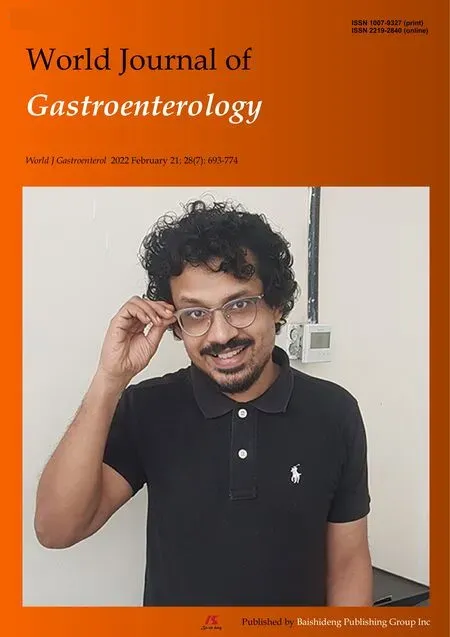Gallbladder biliary lithotripsy: A new rationale applied to old treatment
Lorenzo Dioscoridi,Massimiliano Mutignani
Abstract Pure endoscopic treatment of combined cholelithiasis and choledocholithiasis is possible due to the chance to use together both endoscopic retrograde cholangiopancreatography (ERCP) and endoscopic ultrasound (EUS) approaches. This endotherapy permits to treat biliary stones in the main bile duct by standard ERCP and gallbladder stones by EUS-guided cholecystoduodenostomy eventually associated to intracorporeal lithotripsy to achieve optimal results.
Key Words: Endoscopic ultrasound-guided gallbladder drainage; Biliary lithotripsy;Gallstone lithotripsy; Gallbladder biliary lithotripsy; New rationale
TO THE EDITOR
We read with interest the paper by Cianci and Restini[1 ].
The authors interestingly discussed on indications, advantages and disadvantages of laparoendoscopic rendez-vous, pure laparoscopic common bile duct exploration and sequential laparoscopicendoscopic retrograde cholangiopancreatography (ERCP) approach in combined cholethiasis and choledocholithiasis.
We would like to focus on a totally endoscopic approach to this pathology.
We totally agree with Cianci and Restini[1 ] that ERCP cannot be considered definitive in the treatment of cholecysto-choledocholithiasis, even if associated with lithotripsy, since the genesis of the stones is secondary to the lithogenic bile in the gallbladder. Thus, can we act endoscopically also on gallbladder stones?
Recently, EUS-guided cholecystoduodenostomy was found comparable to laparoscopic cholecystectomy in terms of clinical outcomes[2 ]. Recurrent biliary events after EUS-guided gallbladder drainage can be even lowered by associated lithotripsy.
Historically, many studies demonstrated the ineffectiveness of the gallstone lithotripsy alone with high recurrence rate associated to high rate of adverse events, especially in case of multiple and large stones[3 ,4 ].
In the recent years, the role of this treatment was re-established because of the new endoscopic approaches described for acute cholecystitis; particularly, the increasing role of EUS-guided cholecystoduodenostomy[5 ,6 ] has two main interesting implications in this perspective.
Firstly, EUS-guided gallbladder drainage can be considered as definitive therapy especially in elderly patients unfit for surgery, differently from percutaneous cholecystostomy[4 ]. After endoscopic stable gallbladder drainage in the duodenum, the gallbladder loses its property to concentrate the bile and, so on, to form new gallstones.
In this setting, the opportunity to destroy the gallstones is interesting, on one hand, to avoid eventually obstruction of the biliary edge of the stent (and subsequent relapses of symptoms) or, on the other hand, further migration of biliary gallstones into the infundibulum or into the biliary tree (and subsequent obstruction of the main bile duct), especially in case of hard and large stones.
Intracholecystic lithotripsy can be theoretically performed as biliary standard lithotripsy because effectiveness and adverse events should not be different, as described in few first experiences[6 -8 ]. On the other side, standard endoscopic treatment for lithiasis of the common bile duct can be provided in the same combined session.
The main limitations of EUS-guided gallbladder drainage are still the need of a sufficient loosening of the gallbladder (evaluated at the preliminary EUS) to guarantee a safe puncture and the absence of extraluminal pericholecystic fluid collection.
Moreover, intracorporeal lithotripsy in the setting acute cholecystitis can be associated with higher risk of perforation because of the acute inflammation of the gallbladder walls[7 -9 ].
We encourage further studies on this focus to verify these first results and to improve the outcomes and indications of endoscopic treatments in this field, especially for patients unfit for surgery.
FOOTNOTES
Author contributions:Dioscoridi L and Mutignani M designed research; Dioscoridi L wrote the letter; Mutignani M revised the letter.
Conflict-of-interest statement:None of the authors declare any conflict of interests related to the present paper.
Open-Access:This article is an open-access article that was selected by an in-house editor and fully peer-reviewed by external reviewers. It is distributed in accordance with the Creative Commons Attribution NonCommercial (CC BYNC 4 .0 ) license, which permits others to distribute, remix, adapt, build upon this work non-commercially, and license their derivative works on different terms, provided the original work is properly cited and the use is noncommercial. See: https://creativecommons.org/Licenses/by-nc/4 .0 /
Country/Territory of origin:Italy
ORCID number:Lorenzo Dioscoridi 0000 -0003 -4975 -018 X; Massimiliano Mutignani 0000 -0002 -1272 -4888 .
S-Editor:Fan JR
L-Editor:A
P-Editor:Fan JR
 World Journal of Gastroenterology2022年7期
World Journal of Gastroenterology2022年7期
- World Journal of Gastroenterology的其它文章
- Stereotactic radiotherapy and the potential role of magnetic resonance-guided adaptive techniques for pancreatic cancer
- Will the collaboration of surgery and external radiotherapy open new avenues for hepatocellular carcinoma with portal vein thrombosis?
- Early gastric cancer: A challenge in Western countries
- Crohn’s disease-related ‘gastrocnemius myalgia syndrome’ successfully treated with infliximab: A case report
- Effect of Bifidobacterium longum 35624 on disease severity and quality of life in patients with irritable bowel syndrome
- Clinical online nomogram for predicting prognosis in recurrent hepatolithiasis after biliary surgery: A multicenter, retrospective study
